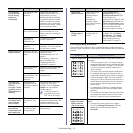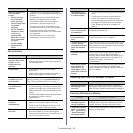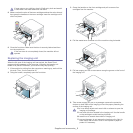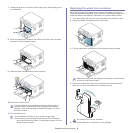
Troubleshooting_ 17
Refer to the Linux User’s Guide that came with your computer for
further information on Linux error messages.
Common Macintosh problems
Refer to the Macintosh User’s Guide that came with your computer for
further information on Macintosh error messages.
I cannot scan via
Gimp Front-end.
Check if Gimp Front-end has Xsane: Device
dialog on the Acquire menu. If not, you should
install Xsane plug-in for Gimp on the your
computer. You can find Xsane plug-in package
for Gimp on Linux distribution CD or Gimp home
page. For the detailed information, refer to the
Help for Linux distribution CD or Gimp Front-end
application.
If you wish to use another kind of scan
application, refer to application’s Help.
I encounter the
“Cannot open port
device file” error
when printing a
document.
Avoid changing print job parameters (via LPR
GUI, for example) while a print job is in progress.
Known versions of CUPS server break the print
job whenever print options are changed and
then try to restart the job from the beginning.
Since Unified Linux Driver locks the port while
printing, the abrupt termination of the driver
keeps the port locked and unavailable for
subsequent print jobs. If this situation occurs, try
to release the port by selecting Release port in
Port configuration window.
The machine does
not appear on the
scanners list.
• E
nsure your machine is attached to your
computer, connected properly via the USB
port, and is turned on.
• En
sure the scanner driver for your machine is
installed in your system. Open Unified Linux
Driver configurator, switch to Scanners
configuration, then press Drivers. Make
sure that driver with a name corresponding to
your machine's name is listed in the window.
• En
sure the port is not busy. Since functional
components of machine (printer and scanner)
share the same I/O interface (port), the
situation of simultaneous access of different
user applications to the same port is possible.
To avoid possible conflicts, only one of them
at a time is allowed to gain control over the
device. The other user will encounter “device
busy” response. This usually happens when
starting a scan procedure. An appropriate
message box appears.
To identify the source of the problem, open
the Ports configuration and select the port
assigned to your scanner, port's symbol
/dev/mfp0 corresponds to LP:0 designation
displayed in the scanners’ options, /dev/mfp1
relates to LP:1, and so on. USB ports start at
/dev/mfp4, so scanner on USB:0 relates to
/dev/mfp4 respectively and so forth
sequentially. In the Selected port pane, you
can see if the port is occupied by another
application. If this is the case, you should
either wait for completion of the current job or
press the Release port button, if you are sure
that the present port application is not
functioning properly.
condition Suggested solutions
The machine does
not scan.
• Ensure a document is loaded into the
machine, ensure your machine is connected
to the computer.
• If
there is an I/O error while scanning.
condition Suggested solutions
The machine does
not print PDF files
correctly. Some
parts of graphics,
text, or illustrations
are missing.
Printing the PDF file as an image may enable
the file to print. Turn on Print As Image from the
Acrobat printing options.
It will take longer to print when you print a
PDF file as an image.
The document has
printed, but the print
job has not
disappeared from
the spooler in Mac
OS X 10.3.2.
Update your Mac OS to Mac OS X 10.3.3. or
higher.
Some letters are not
displayed normally
during the cover
page printing.
Mac OS cannot create the font during the cover
page printing. The English alphabet and
numbers are displayed normally on the cover
page.
When printing a
document in Mac OS
with Acrobat
Reader 6.0 or higher,
colors print
incorrectly.
Make sure that the resolution setting in your
machine driver matches the one in Acrobat
Reader.
condition Suggested solutions


















